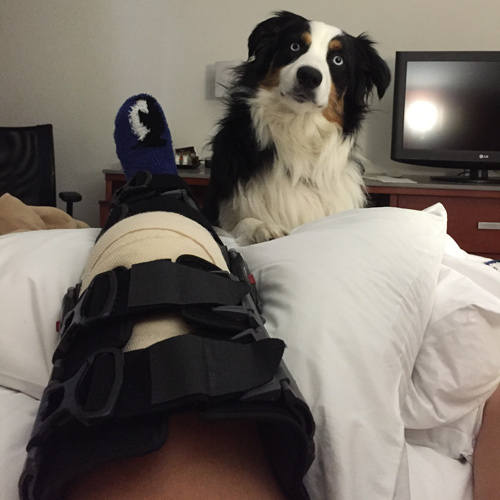Feeling weak in the knees is only good in the romantic sense. In the physical sense, it’s a painfully life-limiting problem, especially when you undergo an injury that requires surgery, whether it be a repair to a torn ligament or a knee replacement, it’s a long and time-consuming road to recovery that can at many times feel like taking on a second job. No more wanderlusting hikes through unexplored places. But, there’s an upside to that second-job that usually ends up making your knees and body stronger than it was before injury. Raise the roof!
I’m about halfway through the in the process of rehabbing my knee back to full strength after surgery to repair a torn ACL and meniscus that happened after a bad landing off a jump while skiing. The recovery process for this particular injury is a full 9-month recovery plan. Sometimes if you tear your meniscus at a particular angle, it cannot be repaired and they just take the damaged chunk out, which is not an ideal long-terms solution. Luckily, my surgeon was able to repair my meniscus, but that meant I needed to be in a straight leg brace for much longer – 6 full weeks so that my meniscus had time to repair fully without any grinding weight on it. The full rehab schedule goes something like this:
 6 weeks post surgery are in a straight leg brace.
6 weeks post surgery are in a straight leg brace. - First 3 weeks are non-weight bearing limited to crutches or the couch
- Next 3 weeks I moved from using a cane to walking peg leg in my brace while working slightly on regaining my range of motion.
- 8 – 12 weeks (2 -3 months) post surgery
- daily physical therapy exercises continuing to work on flexion and range of motion, balance, and regaining leg strength through tons of cycling, leg lifts, leg presses, squats, etc.
- 12 – 20 weeks (3 – 5 months) post surgery:
- Elliptical working into jogging again
- Continuing to strengthen supporting muscles (glutes, quads, hamstrings, and core)
- 20 – 28 weeks (5 – 7 months) post surgery:
- Start plyometrics and sprinting
- Continuing to strengthen supporting muscles (glutes, quads, hamstrings, and core)
- 28 – 36 weeks (7 – 9 months) post surgery:
- Back to cutting and pivoting
- At 9 months back to sports
I’ve spoken to many who did not get their meniscus repaired (only their ACL) and they have come back to full recovery in around 6 months. In that case, depending on how much time and energy you can devote to your rehab process and how old you are, you can fully recover anywhere between 6 months to a year. Obviously the younger your joints are and the more time you have to commit to your rehab, the faster and smoother this process will go. I’m 26 years old with a full time job, so my body hasn’t turned on me yet, but finding the time for rehab definitely required some changes in my routine — earlier mornings, later nights and a lot of hard work.
Related: 3 Easy Exercises to Help Ease Knee Pain
Just like any other dedicated workout program, rehabbing actually starts to become addicting once you begin to see the positive effects of progress. My knee felt as stiff as a board sometimes, and my physical therapy appointments were painful ones, but through regular stretching, I got my full range of motion back incredibly fast. Now it’s all about getting the muscle back and regaining the strength to get back to sports.
Luckily my job does not require me to be on my feet all day, so I didn’t have to take much time off. This was good in the sense that I was kept incredibly busy and time flew by. The hardest part to get used to is the lifestyle change. If you’re used to surfing, running, or going on long hikes to get your mental stress-relief, you can’t do much of that for a long time, and that can just build upon the stress. But just like anything, the beginning is usually be the hardest part, and once you’ve pushed through, you start to almost be happy that you’re being forced to go through this recovery process. Here’s why:
1. You begin to take care of your body more consciously
 Before I went through this procedure, I was pretty active, ate fairly healthy, and what standards consider a healthy human, but I always had a bit of knee problems from skiing and running. None of it was entirely debilitating so I ignored the pain. After going through the surgery, I’ve learned almost everything there is to know about the anatomy of the knee, how to keep it strong and supported, which stretches aid pain in certain areas and how much daily work the body needs to stay at its peak levels. Now I plan on going back into skiing and other actions sports even stronger than I was before I tore my ACL both physically and mentally.
Before I went through this procedure, I was pretty active, ate fairly healthy, and what standards consider a healthy human, but I always had a bit of knee problems from skiing and running. None of it was entirely debilitating so I ignored the pain. After going through the surgery, I’ve learned almost everything there is to know about the anatomy of the knee, how to keep it strong and supported, which stretches aid pain in certain areas and how much daily work the body needs to stay at its peak levels. Now I plan on going back into skiing and other actions sports even stronger than I was before I tore my ACL both physically and mentally.
2. You begin to build habits of discipline
Before my rehab process, it was easy for me to become lackadaisical about my exercise routine and my eating habits. If I had a good excuse to skip the gym I’d do it, and the terms for “good excuse” were typically very broad. Sometimes as broad as just saying “I’d rather catch up on Orange Is The New Black and maybe finally start Breaking Bad”. Though, now if I skip my rehab, I risk far too much: my knee never being as strong as it once was, and never getting to get back to skiing or surfing or hiking without severe limitations. Since the surgery I’ve also been able to easily quit smoking. Yes, I write for a health website and was once considered a smoker. But, because I’ve had to discipline my habits and body, I can easily avoid old triggers that used to make me crave the old habit.
Read more: The Squat Wedge: A Workout Tool Your Knees Need Today
3. You learn to slow down a little bit
When you live in a city like Los Angeles, it can be very easy to get caught up in the whirlwind that this city can sometimes be. There’s creatives everywhere, good art and entertainment are always knocking on your door, much of it for free. The more people you get to know, the more things there are to do. Even if you don’t live in Los Angeles, our fast-paced world has become much more demanding of our time and energy. Meditation classes have begun to sprout up because people are moving so fast, they’ve forgotten how to stop and take a breather, sit in their thoughts for longer than 5 minutes and let life marinate into you. When you become limited physically for an extended period of time, you become a little bit more grateful for those times you had a fully healthy and functioning body and you want to take better care of it. And, you become a little bit more connected to yourself, rather than everything happening around you. And, even though you’re limited temporarily and the mean time can be a tough and physically painful one, you still know it’s just temporary.





